HOW TO CHOOSE A WATER STORAGE SYSTEM


CHOOSE WHICH SYSTEM WORKS BEST FOR YOU
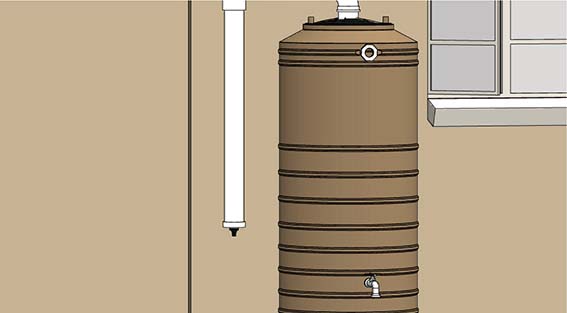

A) Rainwater harvesting
The installation of a tank that is filled automatically when it rains. This will require suitable guttering and piping to transport rainwater to the tank. Free and unlimited water supply (whenever it rains).
Source
Store rainwater accessed from the roof.
Requirements
Rainwater is filtered prior to entering the tank.
Uses
Water is suitable for irrigation, washing, topping up the pool, etc.
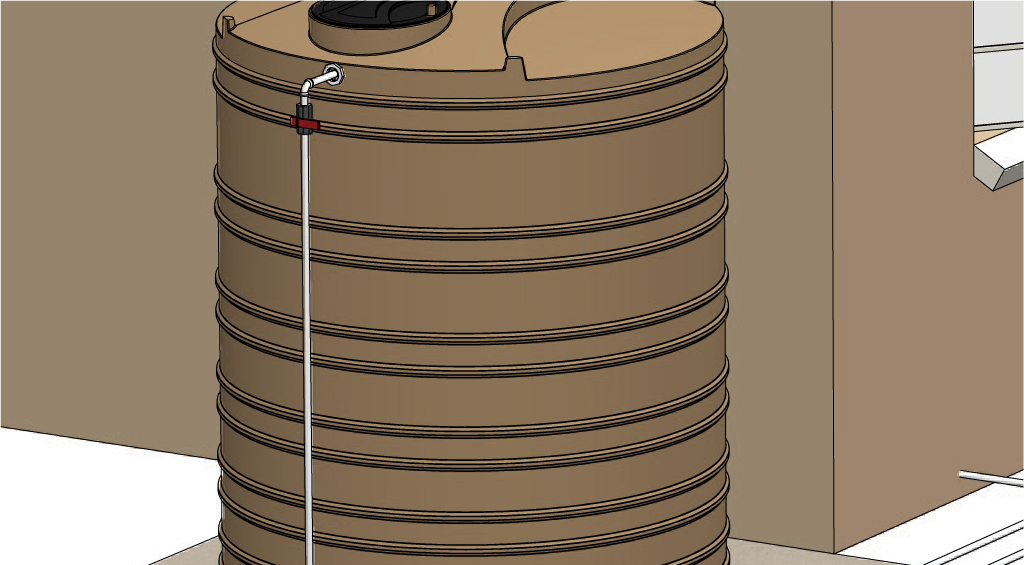

B) Municipal back-up
The installation of a tank that is filled automatically when mains water is available. This water can then be utilised in the event of a cut-off from mains supply. Uninterrupted water supply. Pressure sensor will recognise when municipal water fails and start pump operation.
Source
Municipal water. Tank filled with municipal water.
Requirements
Pump from tank back into main water supply.
Uses
Water is suitable for all household needs.
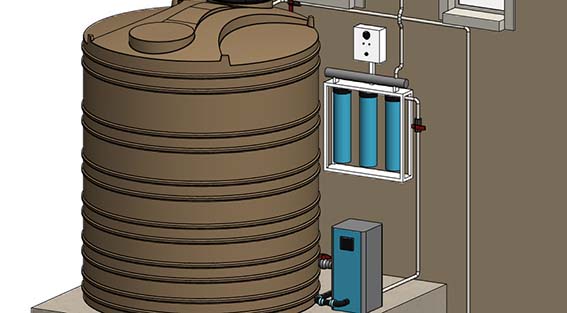

C) Fully integrated
The installation of a tank that is filled automatically when mains water is available to a pre-determined minimum level, with the remaining space available to store rainwater. This water is filtered and sterilised and utilised for full domestic water supply. Combination of both municipal back up and rainwater harvesting. Ensures that there is water available at all times for full domestic use.
Source
Tank filled with municipal water to a
pre-determined minimum level and then
rainwater fills the remaining space.
Requirements
Water is filtered and sterilized.
Uses
Water is suitable for all household needs.
ESTIMATED COSTS TO CONSIDER
Tank
Will vary depending on the size and quantity of the tank(s)
Base/plinth
The tank must be installed on a sound, level and smooth surface. Level paving will suffice, or a properly designed tank stand. Alternatively, a concrete plinth needs to be built.
Concrete plinth 1.5m x 1.5m: 1500L and smaller
Concrete plinth 2m x 2m: 2500L to 5000L
Pre-filtration
Pre-filtration helps remove debris from initial rainwater therefore improving the quality of water entering the tank (you can choose one, two or all three of the options below). It depends on what the water will be used for. This does not apply for the municipal back up system.
- Mesh or tank screen (at top of tank) – helps keep out small debris, insects, etc.
- Rainhead (or leaf eater) - directs leaves and debris away from water flow.
- First flush diverter - flushes away the initial most contaminated rainwater.
Guttering & piping
This will vary depending on the setup. Larger more complex systems will cost more due to additional piping and guttering modifications. If you are considering the fully integrated or municipal back up system it is advisable to make use of a local plumber as it is required to tie into the building’s main water supply line.
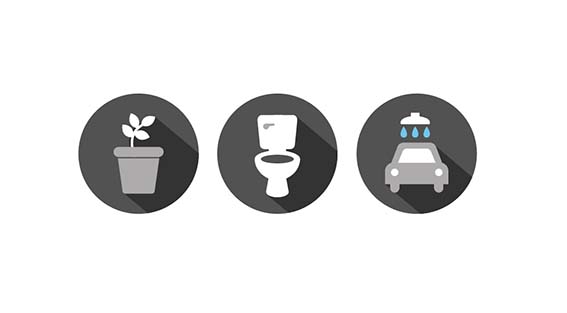

A) Rainwater harvesting
This system is simple, easy and offers advantages like self-sufficiency and the convenience of not being dependent on regulated water resources.
It presents the opportunity to replace high quality drinking water with rainwater for low grade uses such as toilet flushing, irrigation, household cleaning and car washing. As a result, you will save water, reduce your water bill and have access to an adequate water supply when none is available.
When necessary, rainwater can be used for consumption, if properly boiled or sterilized.
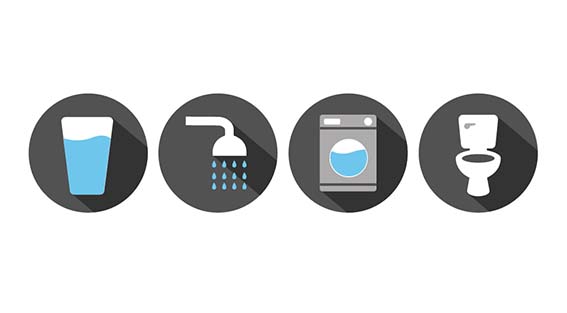

B) Municipal back-up
Municipal back up offers you a pressured water feed solution, providing you with an uninterrupted water supply at all times.
This system is recommended to avoid the inconvenience of water interruptions. It offers you a chance to reduce your reliance on regulated water, with the added bonus that you still have access to clean water and no additional filtration is needed (as with rainwater harvesting).
In ideal conditions municipal water can be stored for extended periods as it is chlorinated.
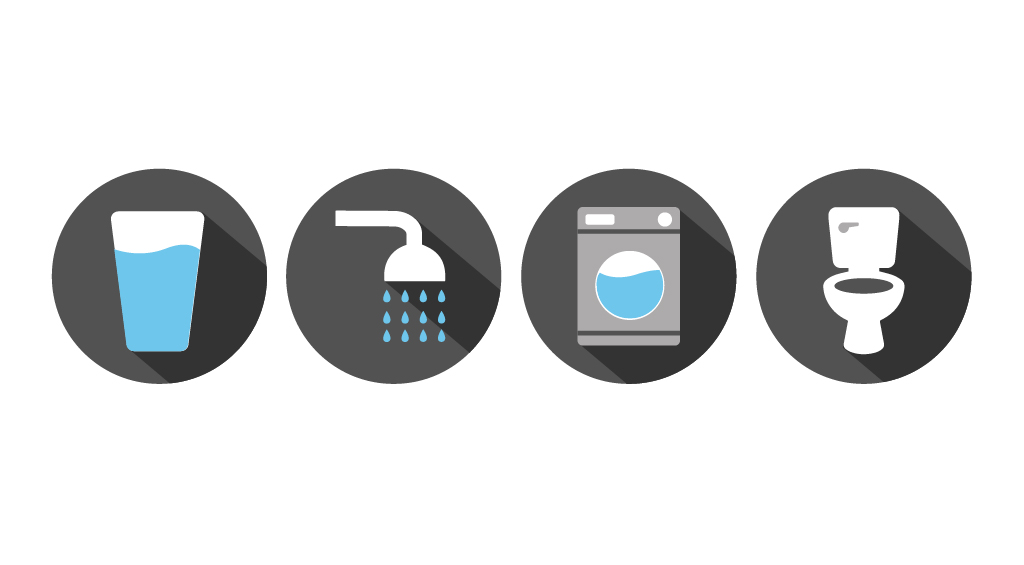

C) Fully integrated
A fully integrated system provides you with municipal back up, and the additional benefit of harvesting rainwater (which is free and makes this system cost effective).
A fully integrated system is a combination of both rainwater harvesting and municipal back up. It has the benefits of reducing your reliance on regulated water (via municipal back up), as well as saving water (via rainwater harvesting), and still gives you access to an adequate water supply when there is none.
The water needs to be filtered and sterilised as it is utilised for full domestic water supply.
BASIC INSTALLATION: Rainwater harvesting
Choose a tank
Here is a guide to estimate what size tank would be sufficient for rainwater harvesting:
| Roof size | Tank size |
| 50 - 100m² | 750L - 22 00L |
| 200 - 400m² | 2 500L - 10 000L |
The biggest challenge with rainwater harvesting is storage capacity.
Tank placement
The tank should preferably be at a downpipe, or repositioned by use of proper piping or guttering.
Foundation options
Tanks must be installed on a sound, level and smooth surface. Level paving will suffice, or a properly designed tank stand. Alternatively, a concrete plinth needs to be built. Ideally the plinth should be covered by a concrete topping at least 85mm thick.
Recommended base sizes are as follows
| Tank | Diameter |
| 750L | 760mm |
| 1 500L | 1410mm |
| 2 200L | 1420mm |
| 2 500L | 1420mm |
| 5 000L | 1820mm |
| 10 000L | 2200mm |
Chamberlains DIY tip!
Make sure the concrete is cured before placing the tank on the slab and remember that the base must not be undermined by overflow water.
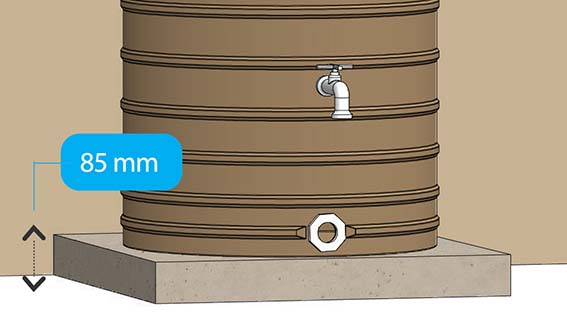

Step 1
Ensure the tank is installed on a suitable base. The base must be sound, level, smooth, free of any protrusions and at least 100mm wider than the base of the tank.
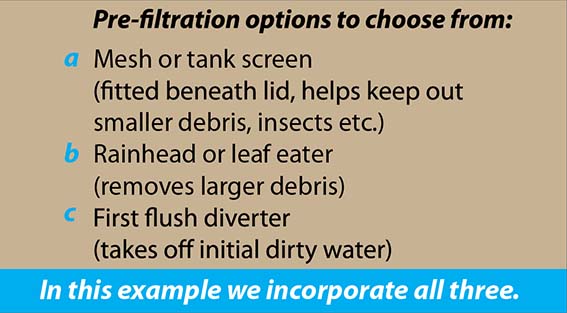

Step 2
Select desire pre-filtration options. Pre-filtration will differ depending on preference and what the water will be used for.
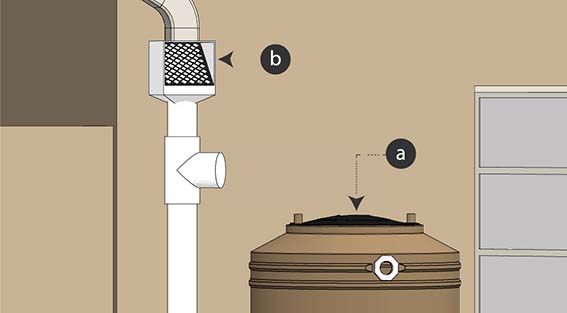

Step 3
a. Mesh or tank screen: Ensure the tank screen is fitted beneath the lid of the tank.
b. Rain head or leaf eater: Fit the leaf eater to the downpipe (vertically or horizontally).
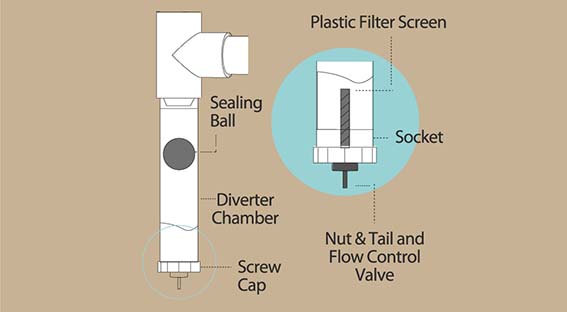

Step 4
c. First flush diverter: Install the first flush diverter as per instructions provided inside packaging.
Note: the first flush utilizes a dependable ball and seal system, requiring no manual intervention.
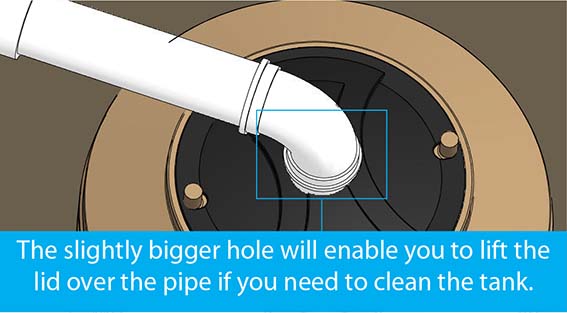

Step 5
Cut a hole of 110.5mm in the middle of the lid and fit the pipe through the hole, stopping before the mesh or tank screen.
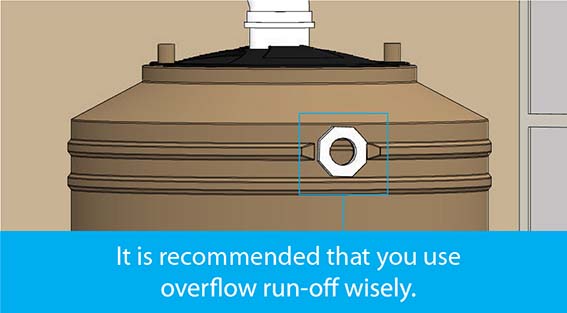

Step 6
Install an additional elbow and pipe to the overflow, and route to the required area.
BASIC INSTALLATION: Municipal back-up
Choose a tank
Here is a guide to estimate what size tank would be sufficient:
| No. of people | 1 | 2 | 3 | 4 | 5 |
| Tank size | 150L | 300L | 450L | 600L | 750L |
Size of tank = litres/day x total days back up required eg. 4 people (600L) x 3 days = 1800L
Tank placement
Should be placed where municipal supply can be intercepted, before entering the house.
Based/Foundation options
Tanks must be installed on a sound, level and smooth surface. Level paving will suffice, or a properly designed tank stand. Alternatively, a concrete plinth needs to be built. Ideally the plinth should be covered by a concrete topping at least 85mm thick.
Recommended base sizes are as follows
| Tank | Diameter |
| 750L | 760mm |
| 1 500L | 1410mm |
| 2 200L | 1420mm |
| 2 500L | 1420mm |
| 5 000L | 1820mm |
| 10 000L | 2200mm |
Chamberlains DIY tip!
Install a gate valve between the house and pump to isolate in case of maintenance.
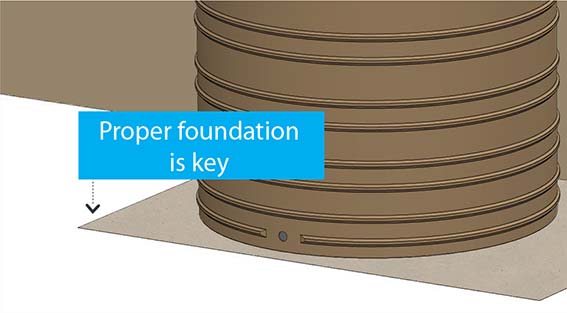

Step 1
Ensure the tank is installed on a suitable base. The base must be sound, level, smooth, free of any protrusions and at least 100mm wider than the base of the tank.
Supply the tank with municipal feed to the float valve at the top of the tank. When full, the float valve will close the water supply and when it drops it will open and allow the tank to be filled.
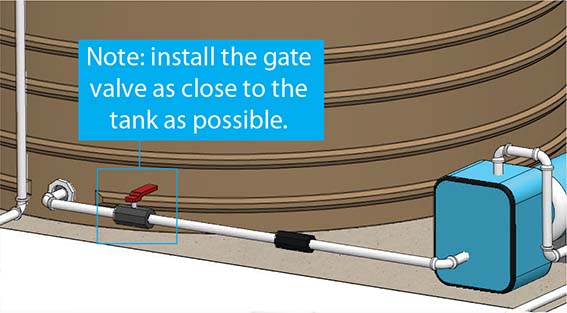

Step 2
Use a minimum 25mm diameter pipe from the tank, to the gate valve, to the pump. Connect the pump to the electrical main supply.


Step 3
Use a minimum 20mm pipe from the pump to cut into mains where possible before the master flow valve.
Install a non-return valve between house and mains to ensure no back pressure to mains.
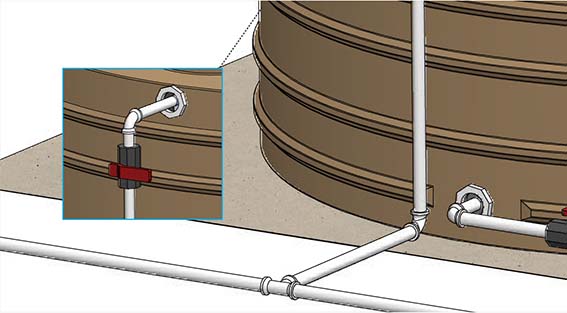

Step 4
Supply the tank with municipal feed to the float valve at the top of the tank. When full, the float valve will close the water supply and when it drops it will open and allow the tank to be filled.
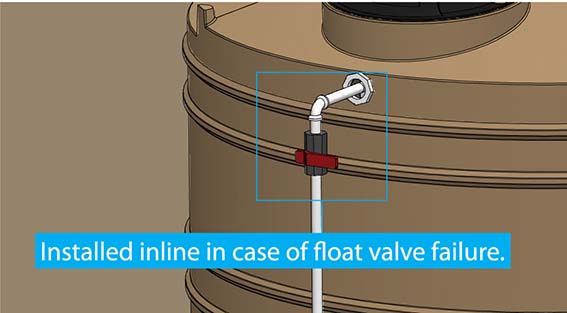

Step 5
Ensure that the gate valve is open and fill the tank from municipal supply.
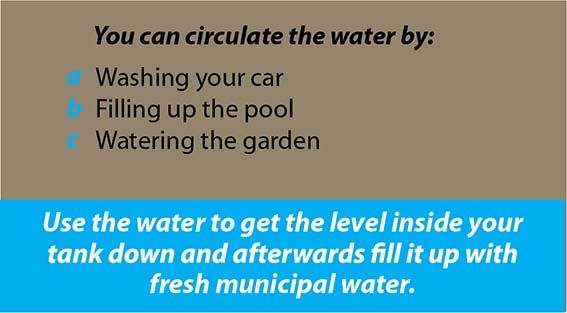

Step 6
It is recommended that the water is run once every two weeks to rotate the water and ensure the system functions properly.
BASIC INSTALLATION: Fully integrated
Choose a tank
Here is a guide to estimate what size tank would be sufficient:
| No. of people | 1 | 2 | 3 | 4 | 5 |
| Tank size | 150L | 300L | 450L | 600L | 750L |
Size of tank = litres/day x total days back up required eg. 4 people (600L) x 3 days = 1800L
Tank placement
Should be placed where municipal supply can be intercepted, before entering the house.
Foundation options
Tanks must be installed on a sound, level and smooth surface. Level paving will suffice, or a properly designed tank stand. Alternatively, a concrete plinth needs to be built. Ideally the plinth should be covered by a concrete topping at least 85mm thick.
Recommended base sizes are as follows
| Tank | Diameter |
| 750L | 760mm |
| 1 500L | 1410mm |
| 2 200L | 1420mm |
| 2 500L | 1420mm |
| 5 000L | 1820mm |
| 10 000L | 2200mm |
Chamberlains DIY tip!
Make sure the concrete is cured before placing the tank on the slab and remember that the base must not be undermined by overflow water.
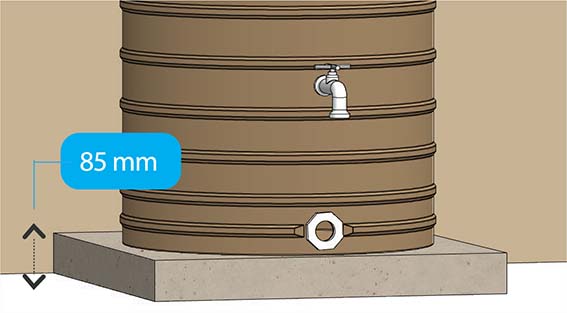

Step 1
Ensure the tank is installed on a suitable base. The base must be sound, level, smooth, free of any protrusions and at least 100mm wider than the base of the tank (refer to pre-installation).
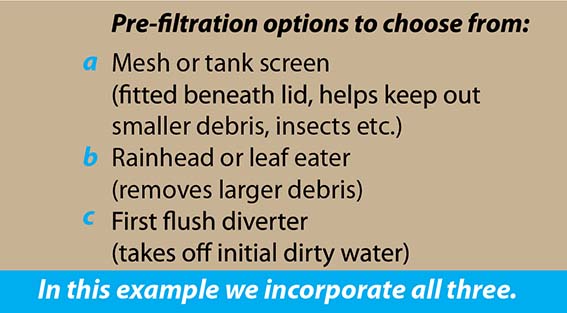

Step 2
Select desired pre-filtration options. Pre-filtration will differ depending on preference and what the water will be used for.
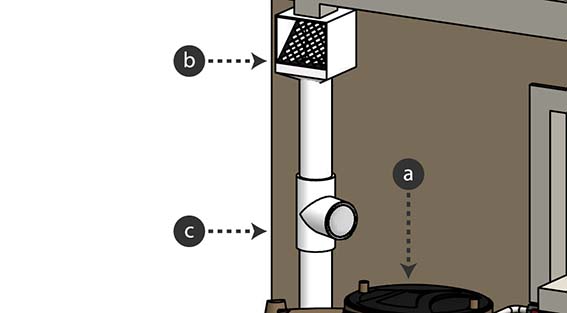

Step 3
Install desired pre-filtration. For detailed instructions refer to steps 3 to 4 on rainwater harvesting installation page.
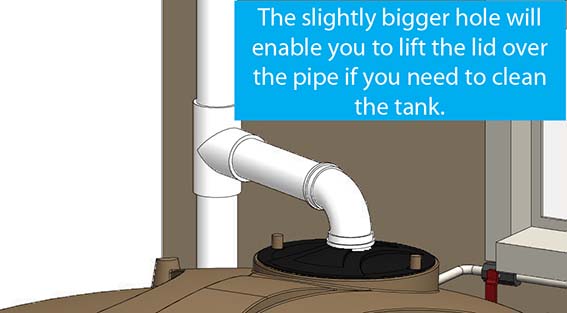

Step 4
Cut a hole of 110.5mm in the middle of the lid and fit the pipe through the hole, stopping before the mesh or tank screen.
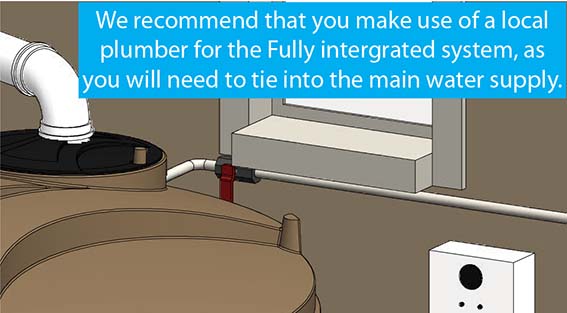

Step 5
For detailed plumbing instructions please refer to steps 2 to 5 on Municipal Back Up Installation page.
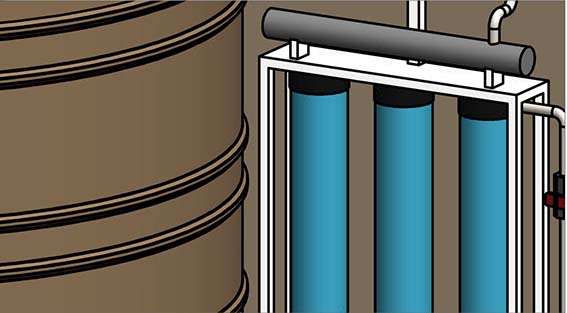

Step 6
Install desired filtration and sterilization unit between the pump and the house.


